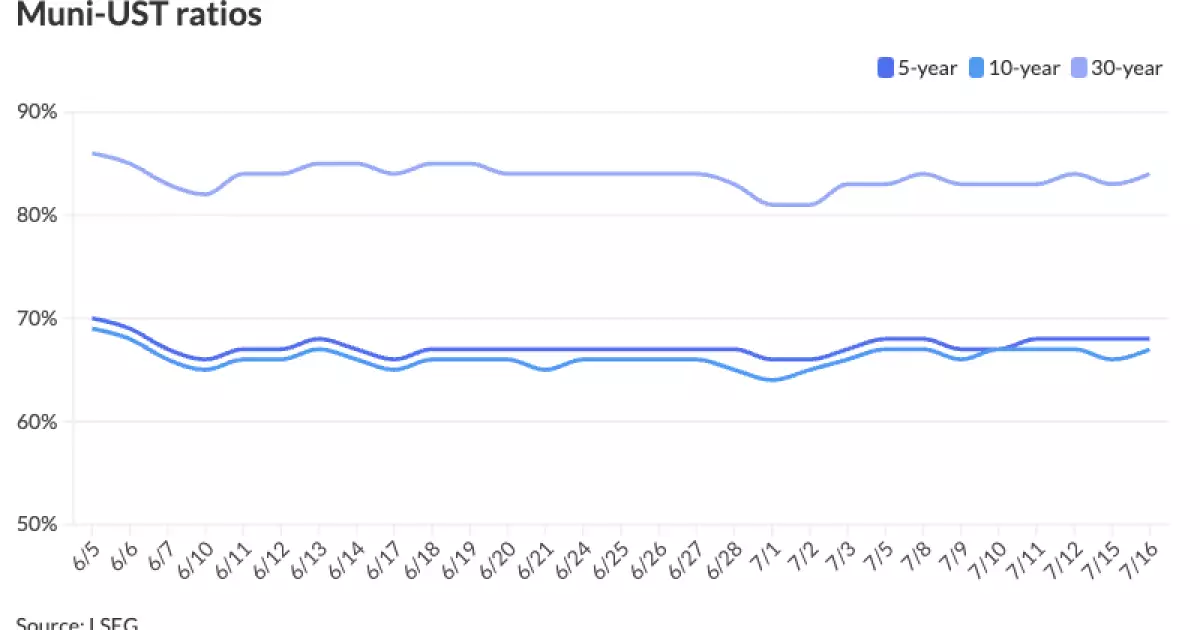On a recent trading day, municipal bonds exhibited a robust performance in secondary markets as new issuance began to gain momentum. This uptick in activity coincided with a decline in U.S. Treasury yields and a positive shift in equity markets, shaping a favorable environment for investors. The recent ratios of municipal consumption against U.S. Treasury yields present a compelling picture of the current market landscape, with two-year munis hovering around 65% of their Treasury counterparts, as reported by Refinitiv Municipal Market Data.
As municipalities witnessed an increase in trading volumes, investors were quick to respond to the potential for greater returns amid mostly stable financial conditions. Traders noted that while short-term securities were demonstrating “overbought” signals, other sections of the municipal yield curve were significantly undervalued. This disparity presents an intriguing opportunity for strategic acquisitions, suggesting that investors could benefit by recalibrating their portfolios toward longer maturities.
The recent consumer price index (CPI) report revealed a slowing inflation trend, which has led many analysts to forecast potential rate cuts from the Federal Reserve as early as next month. Matt Fabian from Municipal Market Analytics has highlighted that this market rally, while promising, may not be comprehensive enough, especially for shorter maturities, which stand to benefit most directly from any forthcoming rate reductions. Given that the market is approaching a point of caution, prudent investment in shorter-term instruments should be carefully considered.
Despite this caution, the municipal market is buoyed by substantial reinvestment activity, with projected reinvestment surging to nearly $40 billion in August—an impressive figure and a notable increase from July’s total. Such accumulation of investment capital indicates that retail investors, drawn by the allure of reasonable income opportunities, are returning to the sector in significant numbers.
Nonetheless, mutual fund flows have displayed considerable volatility, creating a mixed environment for investment strategies. Interestingly, the influx of capital into exchange-traded funds (ETFs) implies that investors are retaining liquidity while awaiting a clearer allocation strategy within tax-exempt sectors. Consequently, brokers have taken a somewhat optimistic approach, allowing inventory levels to build up during the summer months, leading to a decline in supply pressures at the start of July.
The current week witnessed an anticipated increase in issuance, expected to climb to an estimated $10.7 billion. Newly issued bonds from various regions illustrate a significant breadth of activity, with Miami-Dade County’s aviation revenue refunding bonds and the Georgia health system project revenue anticipation certificates among the crowd of new offerings. This enhanced issuance is expected to fuel further interest in the municipal arena, attracting institutional and retail participants alike.
With the market’s attention now turning toward upcoming issues, municipal bond transactions are set to gain added attention this week. The New York City Transitional Finance Authority’s issue of subordinate bonds, which encompasses both taxable and tax-exempt securities, signifies the enduring demand for reliable revenue streams from reputable municipal entities. Alongside this, the Regents of the University of California will soon introduce their general revenue bonds, adding diversity to the market palette.
Further, the San Francisco Public Utilities Commission is preparing to launch a noteworthy issuance of wastewater revenue bonds, underscoring the municipal sector’s continued focus on sustainable infrastructure projects. As issuances proliferate, investors are poised to explore various opportunities across the spectrum of municipal finance, from green bonds to conventional revenue bonds, each offering its unique value proposition.
As market dynamics continue to evolve, the overall sentiment remains cautiously optimistic. Analysts suggest that a rise in supply over the coming weeks should not lead to fears regarding overall sector performance, especially if fund flows stabilize and investor interest remain steady. Many believe that the acute attention on non-SMA maturities and structures could help further cement the strength of municipal bonds.
While challenges remain in terms of inflationary pressures and market sentiment, the current wave of municipal bond issuance coupled with consistent trading patterns offers a window of opportunity for both seasoned and novice investors. The municipal sector is poised to maintain its relevance as a cornerstone of fixed-income investment, especially as the landscape becomes increasingly influenced by broader economic narratives.

